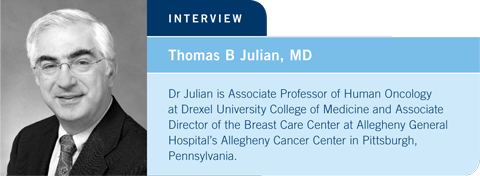
 |
||||||||||||||

| Tracks 1-9 | ||||||||||||||||||||
|
Select Excerpts from the Interview
Track 2
![]() DR LOVE: In which situations are you using MRI for patients who are
not enrolled in a clinical trial?
DR LOVE: In which situations are you using MRI for patients who are
not enrolled in a clinical trial?
![]() DR JULIAN: We screen patients at high risk for breast cancer with MRI, and
in that population of patients we have detected a few with breast cancer that
were not identified by mammogram.
DR JULIAN: We screen patients at high risk for breast cancer with MRI, and
in that population of patients we have detected a few with breast cancer that
were not identified by mammogram.
These are individuals who have a significant family history of first- and second-degree relatives with breast cancer and carriers for the BRCA1 and BRCA2 gene. Most of the time, these are individuals with a dense breast as determined by mammography.
The other group of patients in whom we’re utilizing MRI are those with newly diagnosed cancer and a fairly dense breast. They may be premenopausal, perimenopausal or postmenopausal and treated with hormone therapy, which affects the density of the tissue. We evaluate the MRI to determine the extent of the disease and to provide a better approximation of the size of the tumor.
We’re also using MRI in the neoadjuvant setting for patients with large tumors who would like to have a breast-conserving procedure. We evaluate the breast with an MRI to determine the tumor size, then administer neoadjuvant chemotherapy and follow a sequence to ensure that there is a reduction in the tumor size.
Ultimately, MRI aids in the final surgical planning if you’re going to perform breast-conserving surgery. A complete clinical response is a great finding on the MRI. Unfortunately, I don’t believe there’s been enough information to equate a complete clinical response on an MRI with a complete pathologic response.
Tracks 4-5
![]() DR LOVE: How do patients respond to the NSABP-B-42 trial, which is
evaluating whether an adjuvant aromatase inhibitor should be continued
beyond five years?
DR LOVE: How do patients respond to the NSABP-B-42 trial, which is
evaluating whether an adjuvant aromatase inhibitor should be continued
beyond five years?
![]() DR JULIAN: It’s a bit of a mix because you have two groups of patients. One
group says, “I have no problem being on the antihormonal therapy for five
years, but I don’t want to continue taking a pill.” Those patients will not be
excited about NSABP-B-42.
DR JULIAN: It’s a bit of a mix because you have two groups of patients. One
group says, “I have no problem being on the antihormonal therapy for five
years, but I don’t want to continue taking a pill.” Those patients will not be
excited about NSABP-B-42.
The other group of patients says, “I’m worried. I’ve been on this therapy for five years. How do I know that I am going to do as well if you take me off of it?” Obviously the answer is, “We don’t have a good handle on that.” We know historically from the tamoxifen trial that the outcomes were no better with 10 years versus five years (Fisher 2001). With the aromatase inhibitors, there may or may not be an advantage.
The problem we’re faced with is the potential for side effects of the aromatase inhibitor for the additional period of time. However, a number of patients do not feel comfortable coming off of the aromatase inhibitor at five years. They view it as a security blanket.
I believe the NSABP-B-42 results are going to be important. If there is a major benefit to continuing the aromatase inhibitor for 10 years, then the patients need to know that to make an informed decision. If there is no benefit, we can save the patients from the side effects.
| Table of Contents | Top of Page |